Crescent Sustainability Initiatives
Affordable and Clean Energy (SDG 7)
Commitment to Upgrading Energy Efficiency
The initiative to upgrade existing buildings to higher energy efficiency is a cornerstone of sustainable development at B. S. Abdur Rahman Crescent Institute of Science and Technology (BSACIST). This commitment aligns with the broader definition of sustainability, which emphasizes meeting present needs without compromising future generations’ ability to meet theirs. By focusing on energy-efficient upgrades, BSACIST aims to minimize its environmental impact, reduce operational costs, and enhance the overall quality of life for its occupants. The university recognizes that the built environment significantly influences energy consumption and resource use, making these upgrades essential for fostering a sustainable campus.
Comprehensive Sustainability Measures
BSACIST’s approach to upgrading buildings encompasses a wide range of sustainability measures that address various aspects of energy efficiency. The campus incorporates advanced technologies such as high-performance insulation, energy-efficient Heating, Ventilation, and Air Conditioning (HVAC) systems, and renewable energy investments, including solar panels. These upgrades are designed to reduce energy consumption significantly, with comprehensive simulation studies indicating potential reductions of up to 10.5% in energy use across various buildings. The integration of these technologies not only lowers energy costs but also contributes to the university’s goal of achieving a “Net Zero Energy Building,” where energy generation meets or exceeds consumption.
Water and Resource Efficiency
In addition to energy efficiency, BSACIST emphasizes water conservation and resource management as part of its sustainability upgrades. The implementation of rainwater harvesting systems and on-site wastewater treatment facilities exemplifies the university’s commitment to responsible water use. By treating 100% of wastewater on-site and utilizing it for flushing and irrigation, BSACIST effectively reduces its reliance on external water sources. Furthermore, the selection of native and adaptive landscaping species minimizes water requirements, showcasing a holistic approach to resource management that complements energy efficiency efforts.
Enhancing Indoor Environment Quality
Upgrading buildings for higher energy efficiency also involves improving indoor environmental quality. BSACIST has adopted measures to ensure that indoor air quality is prioritized, including the use of low volatile organic compounds materials, adequate ventilation, and natural lighting. These enhancements not only contribute to energy savings but also promote the health and well-being of students and staff. By creating spaces that are conducive to learning and productivity, the university fosters an environment where occupants can thrive, thereby enhancing overall performance and satisfaction.
A Vision for a Sustainable Future
In summary, BSACIST’s plans to upgrade existing buildings to higher energy efficiency reflect a comprehensive commitment to sustainability. By integrating energy-efficient technologies, water conservation practices, and indoor environmental quality measures, the university is setting a benchmark for sustainable practices in higher education. This proactive approach not only reduces the ecological footprint of the campus but also serves as a model for other institutions aiming to achieve similar sustainability goals. As BSACIST continues to invest in these initiatives, it reinforces its vision of transforming the campus into a green, sustainable environment that benefits both current and future generations.
Enhanced Energy Efficiency – Campus Development Plan
Commitment to Sustainable Practices
Upgrading existing buildings to higher energy efficiency is a critical step in fostering sustainable practices within campus environments. The initiative transcends mere compliance with regulatory requirements; it embodies a strategic commitment to minimizing the environmental impact of our university infrastructure. By leveraging modern engineering and sustainable materials, institutions can significantly reduce energy consumption, thus lowering greenhouse gas emissions and contributing to a healthier environment for current and future generations.
Figure VII (2.2) – 1 : Campus Map of Energy Effiency Initiatives
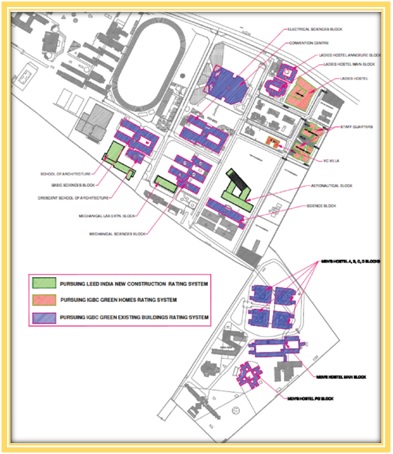

Strategic Planning for Energy Efficiency
The BSACIST campus layout, as depicted in the accompanying map, reflects a meticulous strategy for implementing energy-efficient upgrades. Key buildings, including the Crescent School of Architecture, Basic Science Block, and Mechanical Science Block, are categorized according to their engagement with various sustainability rating systems, such as the Leadership in Energy and Environmental Design (LEED) India New Construction Rating System and the IGBC Green Homes and Green Existing Buildings Rating Systems. This distinct colour coding not only clarifies each building’s status but also underscores the university’s commitment to integrating sustainable practices throughout its operations.
Forward-Thinking New Constructions
Buildings within the LEED rating system, such as the KBA Men’s Hostel (Phase II) at BSACIST, represent a progressive approach to construction. By prioritizing energy efficiency, waste reduction, and the use of sustainable materials from the outset, these structures establish benchmarks for future projects. This proactive strategy not only lowers operational costs but also enhances the living and learning environments for students and faculty, promoting a culture of sustainability across the campus.
Renovating Older Infrastructure
The IGBC Green Existing Buildings rating system highlights the university’s commitment to modernizing older infrastructures, such as the Electrical Science Block, Convention Center, Ladies Hostel, and Quarters. This initiative involves assessing and retrofitting these spaces with energy-efficient technologies, breathing new life into them while significantly lowering their ecological footprints. These upgrades not only enhance operational efficiency but also serve as exemplary models of how institutions can honor their heritage while embracing contemporary sustainability standards.
A Legacy of Environmental Stewardship
In conclusion, the strategic planning for energy efficiency at BSACIST illustrates a comprehensive commitment to sustainability across new and existing infrastructures. By integrating energy-efficient practices and sustainable materials, the university not only enhances its buildings but also fosters a culture of environmental responsibility. The careful categorization of projects under various sustainability rating systems, combined with proactive measures for both new constructions and the retrofitting of older buildings, establishes BSACIST as a leader in sustainable practices within higher education. This holistic approach not only reduces operational costs but also creates a vibrant and environmentally conscious campus, setting a standard for others to follow in the pursuit of sustainability.
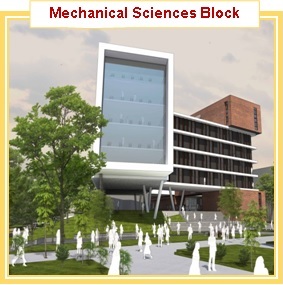
Figure VII (2.2) – 2 : Mechanical Science Block
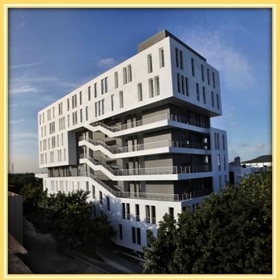
Figure VII (2.2) – 3 : Life Science Block
To enhance energy efficiency and reduce overall energy consumption by approximately 10.5%, comprehensive simulation studies were conducted to model the buildings’ energy-consuming systems. These studies provided a thorough understanding of where energy savings could be realized, leading to the implementation of various energy measures.
1. AAC/Aerocon Blocks and Energy-Efficient Roof Configurations:
The use of walls constructed from AAC (Autoclaved Aerated Concrete) or Aerocon blocks, along with energy-efficient roofing materials, helps to minimize heat ingress, which is crucial for maintaining comfortable indoor temperatures and reducing cooling demands.
2. Efficient Chiller Machines:
Upgrading to more efficient chiller machines is essential for optimizing cooling performance while consuming less energy. These machines provide better thermal comfort with less energy expenditure.
3. Variable Frequency Drives:
Incorporating variable frequency drives in pumps, cooling towers, and air handling units (AHUs) allows for the regulation of energy consumption based on real-time occupancy. This ensures that energy is used effectively, as the system adapts to the actual demand rather than operating at a constant high capacity.
4. Heat Recovery Wheels:
The installation of heat recovery wheels contributes to energy efficiency by recovering waste heat and reusing it, thereby reducing the overall energy required for heating and cooling.
5. High-Performance Glass:
Selecting high-performance glass that allows minimal heat transfer is another significant measure. This not only reduces the cooling load during hot months but also enhances the building’s thermal insulation properties.
6. Efficient Lighting Design:
The lighting design incorporates energy-efficient solutions, such as compact fluorescent lamps (CFLs) and T5 bulbs, which provide higher brightness with lower energy consumption.
7. Low Power Consumption Fans:
The use of fans designed to consume less power contributes to overall energy savings while ensuring adequate ventilation and comfort.
8. Optimized Lighting Design:
The lighting layout has been carefully planned to maximize visual comfort while minimizing overall lighting power density, ensuring an efficient use of energy.
9. External Fins and Shading:
Implementing external fins and shading devices reduces direct sunlight penetration, further lowering cooling demands and enhancing thermal comfort within the buildings.
By adopting these measures, BSACIST not only enhances energy efficiency but also sets a strong foundation for sustainable building practices that can be modelled by other institutions aiming for similar goals.
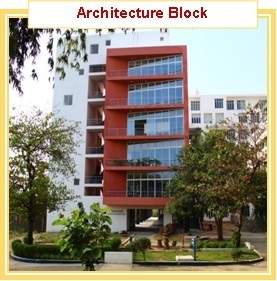
Figure VII (2.2) – 4 : Architecture Block
The project aims to transform the building into a “Net Zero Energy Building,” wherein it will produce more energy than it consumes. This ambitious goal is central to promoting sustainable practices in architecture and design. By incorporating a range of innovative energy-efficient features and sustainable materials, the building aspires to set a precedent for academic institutions in the region, potentially becoming the first of its kind in South India.
Key Design Features:
- Walls Made of Autoclaved Aerated Concrete (AAC) /Aerocon Blocks:The use of Autoclaved Aerated Concrete (AAC) or Aerocon blocks in the construction of walls is a significant step towards enhancing thermal insulation. These materials not only provide structural integrity but also help in reducing heat ingress, contributing to lower energy consumption for cooling.
- Efficient Air Conditioning System:A state-of-the-art air conditioning system will be implemented to optimize energy use while maintaining comfort. This system will be designed to cater to the building’s specific thermal load requirements, ensuring effective climate control with minimal energy wastage.
- Selection of High-Performance Glass:High-performance glazing will be utilized to minimize heat transfer through windows. This selection significantly reduces the reliance on artificial cooling and enhances the overall energy efficiency of the building.
- Efficient Lighting Design:The lighting design incorporates compact fluorescent lamps (CFLs) and T5 bulbs, which provide sufficient illumination while consuming less energy. This efficient lighting strategy supports the building’s sustainability goals by reducing energy demand during operational hours.
- Reflective Roof with Under Deck Insulation:The roof is designed to reflect sunlight, thereby minimizing heat absorption. Coupled with under-deck insulation, this feature helps to maintain a comfortable indoor climate and lowers the need for mechanical cooling.
- Heat Recovery Wheels:These systems will be integrated to capture and reuse waste heat from various building operations, enhancing overall energy efficiency. By recapturing energy that would otherwise be lost, the building will further reduce its reliance on external energy sources.
- Low Power Consumption Fans:To complement the efficient cooling and ventilation strategies, low power consumption fans will be installed. These fans are designed to operate effectively while using significantly less energy than traditional models.

Figure VII (2.2) – 5 : Staff Quarters
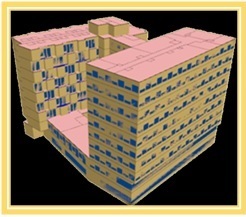
Figure VII (2.2) – 6 : Ladies Hostel
Energy Efficiency Strategies
The comprehensive simulation studies conducted for the building aimed to analyze and optimize various energy-consuming systems, leading to an overall energy consumption reduction of approximately 25%. This proactive approach emphasizes the commitment to sustainable building practices and highlights several key strategies to enhance energy efficiency.
Natural Lighting Optimization
The design of the building is focused on maximizing natural light penetration. With over 75% of each apartment strategically oriented to make the best use of daylight, the reliance on artificial lighting during the day is significantly minimized. This not only creates a more pleasant living environment but also contributes to substantial energy savings by reducing electricity demand for lighting.
High-Performance Building Envelope
Employing high-performance building envelope materials, such as AAC (Autoclaved Aerated Concrete) blocks, plays a crucial role in reducing heat ingress. These materials effectively insulate the building, helping to maintain comfortable indoor temperatures. By decreasing the necessity for heating and cooling, the reliance on energy-intensive HVAC systems is significantly lowered, leading to further reductions in energy consumption.
Efficient Lighting and Energy Monitoring Systems
To enhance energy efficiency further, the building is equipped with efficient lighting systems that minimize energy use without compromising illumination. Additionally, a detailed metering system has been implemented to ensure continuous measurement and monitoring of all energy systems within the building. This allows for real-time data collection, enabling efficient management of resources and identification of areas for improvement.
Integration of Renewable Energy Systems
The building also incorporates a solar hot water system, which utilizes renewable energy to meet water heating requirements. This not only reduces reliance on conventional energy sources but also supports the building’s sustainable objectives by integrating green technologies.
Additional Energy-Efficient Features
To further enhance energy performance, the building adheres to minimum Bureau of Energy Efficiency (BEE) standards, targeting 4 or 5-star ratings. Furthermore, the incorporation of external shading devices helps control solar heat gain, improving overall comfort and reducing the need for mechanical cooling.


Figure VII (2.2) – 7 : Vice Chancellor’s Villa
Comprehensive simulation studies have been pivotal in modelling the energy-consuming systems of the building, leading to an impressive reduction in overall energy consumption of about 25%. These studies informed a series of strategic design decisions aimed at optimizing energy efficiency across various dimensions.
- Window to Wall Ratio: The building features an optimal design for its window-to-wall ratio, ensuring that windows are strategically placed to maximize natural light while minimizing heat gain. This balance is crucial in creating a comfortable indoor environment and reducing reliance on artificial lighting.
- Natural Lighting Utilization: The design effectively harnesses natural light, ensuring that over 75% of each apartment is well-lit during the day. This thoughtful approach minimizes the need for artificial lighting, thereby conserving energy.
- External Shading Devices: To further enhance energy efficiency, external shading devices have been incorporated into the design. These devices play a critical role in reducing solar radiation exposure, thereby contributing to a more stable indoor temperature and decreasing the demand for cooling.
- High-Performance Building Envelope: The building incorporates a high-performance envelope using AAC (Autoclaved Aerated Concrete) blocks. This choice significantly reduces heat ingress, which helps in lowering the overall energy requirements for heating and cooling.
- Efficient Lighting Systems: The implementation of efficient lighting systems is essential for reducing overall energy consumption. By utilizing modern, energy-saving bulbs, the building ensures adequate illumination while minimizing electricity usage.
- Solar Hot Water System: The provision of a solar hot water system integrates renewable energy into the building’s operational strategy. This system significantly reduces the dependency on conventional energy sources for heating water, aligning with sustainability goals.
- Adherence to BEE Standards: Lastly, the building meets minimum Bureau of Energy Efficiency (BEE) standards, targeting a rating of 4 or 5 stars. This commitment to energy efficiency is reflected in the choice of split units that are CFC-free, further enhancing the building’s sustainable profile.
Holistic Sustainability: Transforming Campus Energy Ecosystem
By integrating multiple approaches – solar power generation, energy-efficient technologies, smart infrastructure design, and collaborative student-driven projects – B.S. Abdur Rahman Crescent Institute of Science and Technology, has created a holistic framework for upgrading buildings to higher energy efficiency. The institute’s commitment goes beyond mere technological implementation, fostering a culture of sustainability and innovation. These strategic upgrades not only reduce operational costs and carbon footprint but also serve as a model for sustainable institutional development, demonstrating how existing infrastructure can be transformed into energy-efficient, environmentally responsible spaces.
Strategic Solar Infrastructure: BSACIST’s Comprehensive Energy Efficiency Approach
B.S. Abdur Rahman Crescent Institute of Science and Technology (BSACIST) has implemented a comprehensive strategy to upgrade existing buildings to higher energy efficiency through innovative renewable energy solutions. As part of its ‘Green Campus’ initiative, the institute has installed multiple rooftop solar photovoltaic power plants with a total capacity of 650 kWp, strategically positioned across various campus buildings. These solar installations include a 550 kWp grid-tied plant on academic buildings and a recently added 100 kWp plant in the New Architecture Block and CIIC Block, demonstrating a systematic approach to energy infrastructure upgrades.
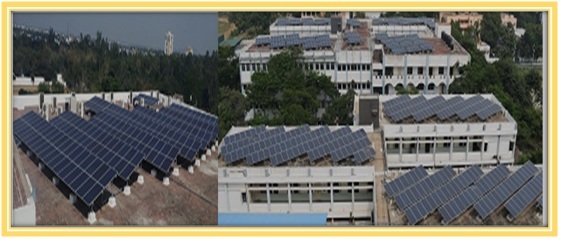
Figure VII (2.2) – 8 :Solar panel installed at roof top in various buildings
Quantifying Success: Solar Power Generation and Financial Savings
The solar power implementation has yielded significant energy efficiency improvements.
Table VII (2.2) – 1 : Total Solar Power Generation – 650kWp up to from 2014 to 2023
| Plant | Units | Amount Saved |
| 150Kwp | 16,14,426 | 1,47,77,494 |
| 100kWp | 12,24,046 | 1,13,85,248 |
| 300kWp | 17,59,980 | 1,72,16,042 |
| New 100kWp | 3,31,420 | 33,33,444 |
| Total | 49,29,872 | 4,67,12,228 |
These solar installations now constitute 18% of the total electricity consumption since June 2014, representing a substantial upgrade in the campus’s energy efficiency infrastructure.
Innovative Energy Solutions: Beyond Solar Power Generation
Beyond solar power, BSACIST has implemented complementary energy-efficient technologies to upgrade existing buildings. A notable example is the installation of solar water heating systems with a total capacity of 39,500 litres, equivalent to 365 electric geysers of 2kW capacity. These systems are strategically placed in Men’s Hostel blocks, Ladies Hostel, and New Staff Quarters, estimated to save approximately 24 lakhs in power consumption annually. The institute has also introduced innovative solutions like zero-export devices to manage surplus solar power generation and prevent potential damage to diesel generator sets.
Figure VII (2.2) – 9 : Solar Water Heater – Men’s Hostel, Ladies Hostel and Staff Quarters

Table VII (2.2) – 2 : Water generated through Solar Heater
| Block | No. of tanks | Capacity in litres |
| Men’s Hostel | ||
| A Block | 20 | 5000 |
| B Block | 6 | 3000 |
| C Block | 6 | 3000 |
| D Block | 8 | 4000 |
| Main block | 20 | 5000 |
| PG block | 12 | 3000 |
| Ladies Hostel | ||
| Main block | 10 | 5000 |
| Annexure Block | ||
| New Block Phase 1 | 17 | 5750 |
| Staff Quarters | ||
| New Staff Quarters | 23 | 5750 |
| Total Capacity | 122 | 39,500 Litres |
Smart Infrastructure: Collaborative Energy Management Strategies
To further enhance energy efficiency, the institute has developed additional infrastructure improvements. Solar street lighting projects have been implemented along the road connecting staff quarters to the men’s hostel and the architecture block – a collaborative effort between third-year electrical engineering students and the estate electrical department. The zero-export device ensures that excess power generated by the solar power plant does not damage the diesel generator sets, while allowing the solar power to be shared across the campus grid during load shedding.
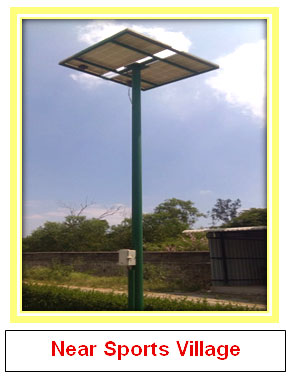
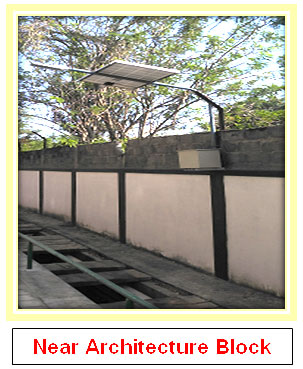
Figure VII (2.2) – 10 : Solar Lamp – Near Sports Village and Architecture block
POLICY FOR ENERGY-EFFICIENT RENOVATION AND BUILDING
Issue: 04; Revised on 2023
| Policy Created on | July 2009 |
| 1st Revision amended on | IQAC Meeting held on 27th October 2017 |
| 2nd Revision amended on | IQAC Meeting held on 31st March 2021 |
| 3rd Revision amended on | IQAC Meeting held on 16th June 2023 |
Responsible Executive : Director (IQAC)
Responsible Office : Internal Quality Assurance Cell, Estate Office, and SDG Cell
Contacts : Registrar, Director (IQAC)
The B.S. Abdur Rahman Crescent Institute of Science and Technology is committed to ensuring that all renovations and new constructions on campus adhere to stringent energy efficiency standards. This policy aims to:
- Ensure universal access to affordable, reliable, modern energy services.
- Increase substantially the share of renewable energy in the global energy mix.
- Double the global rate of improvement in energy efficiency
- Enhance international cooperation to facilitate access to clean energy research and technology.
- Expand infrastructure and upgrade technology to supply modern and sustainable energy services, particularly in developing countries.
7.2 REASON FOR THIS POLICY
This policy is established to promote energy-efficient practices in renovating existing infrastructures and constructing new buildings. By adhering to energy efficiency standards, the Institute aims to reduce greenhouse gas emissions, lower operational costs, and contribute to the global efforts to combat climate change, which aligns with SDG 7 – Affordable and Clean Energy.
7.3 RESPONSIBILITIES
7.3.1 Policy Principles
The Institute shall implement the following principles to ensure compliance with energy efficiency standards:
- All renovations and new constructions must achieve recognised building rating systems such as EDGE, IGBC, and LEED.
- Sustainable design features, including using renewable energy sources, shall be integrated into all projects.
- An efficient waste management plan shall be established to minimize waste and promote recycling.
- Rainwater harvesting systems shall be implemented in all new buildings.
- Energy conservation shall be prioritized through the installation of energy-efficient appliances and equipment.
- Regular audits of energy consumption shall be conducted to identify areas for improvement.
- Use of low VOC (Volatile Organic Compounds) materials in construction and renovation to minimize harmful emissions.
- Adoption of eco-friendly housekeeping practices using biodegradable chemicals.
- Implementation of high reflective roofing materials and green roofs to reduce heat island effects.
- Encourage water-efficient landscaping and high-efficiency irrigation technology in new construction projects.
- Support R&D activities towards energy-efficient renovation and building.
- Enhance national/international cooperation to facilitate access to green building technology.
- Dissemination of Policy
- Awareness programs shall be conducted regularly for all stakeholders regarding energy-efficient practices.
- This policy shall be publicly accessible on the Institute’s website and updated as necessary.
7.3.3 Enforcement of Policy
- The Director (Planning and Development) and their team are responsible for monitoring compliance with this policy.
- Compliance shall be communicated to architects, design engineers, and construction workers involved in projects.
7.2.1 – ENERGY EFFICIENCY POLICY.pdf
POLICY FOR DIVESTMENT FROM CARBON-INTENSIVE ENERGY INDUSTRIES
Issue: 04; Revised on 2023
| Policy Created on | July 2009 |
| 1st Revision amended on | IQAC Meeting held on 27th October 2017 |
| 2nd Revision amended on | IQAC Meeting held on 31st March 2021 |
| 3rd Revision amended on | IQAC Meeting held on 16th June 2023 |
Responsible Executive: Director (IQAC)
Responsible Office: Internal Quality Assurance Cell, Estate Office, and SDG Cell
Contacts: Registrar, Director (IQAC)
The B.S. Abdur Rahman Crescent Institute of Science and Technology is committed to divesting from carbon-intensive energy industries, particularly coal and oil, to promote sustainable energy practices and contribute to the global efforts to combat climate change. This policy aims to:
- Ensure universal access to affordable, reliable, and modern energy services.
- Increase substantially the share of renewable energy in the global energy mix.
- Double the global rate of improvement in energy efficiency.
- Enhance international cooperation to facilitate access to clean energy research and technology.
- Promote investment in energy infrastructure and clean energy technology.
7.2 REASON FOR THIS POLICY
This policy is established to minimize the Institute’s carbon footprint by reducing investments in fossil fuels and promoting renewable energy sources. By divesting from carbon-intensive industries, the Institute aligns with the United Nations’ Sustainable Development Goals, particularly SDG 7: Affordable and Clean Energy, and supports the transition to a sustainable energy future.
7.3 RESPONSIBILITIES
7.3.1 Policy Principles
The Institute shall implement the following principles to ensure effective divestment from carbon-intensive energy industries:
- Conduct a comprehensive review of current investments to identify carbon-intensive assets.
- Gradually divest from all investments in coal and oil industries within a specified timeframe.
- Reallocate funds towards renewable energy projects and sustainable technologies.
- Collaborate with financial institutions that prioritize sustainable investment practices.
- Promote transparency in investment decisions and publicly report on divestment progress.
- Engage with stakeholders, including students and faculty, to raise awareness about the importance of divestment from fossil fuels.
- Support research and development initiatives focused on clean energy technologies.
7.3.2 Dissemination of Policy
- This policy shall be publicly accessible on the Institute’s website to ensure transparency.
- Awareness programs shall be conducted regularly for all stakeholders regarding the importance of divestment from carbon-intensive industries.
- Updates on divestment progress shall be communicated through newsletters and reports.
7.3.3 Enforcement of Policy
- The Director (Finance) and their team are responsible for monitoring compliance with this policy and reporting on divestment progress.
- Any breach of this policy may result in a review of investment strategies and potential disciplinary actions as prescribed by the Institute’s code of conduct.


